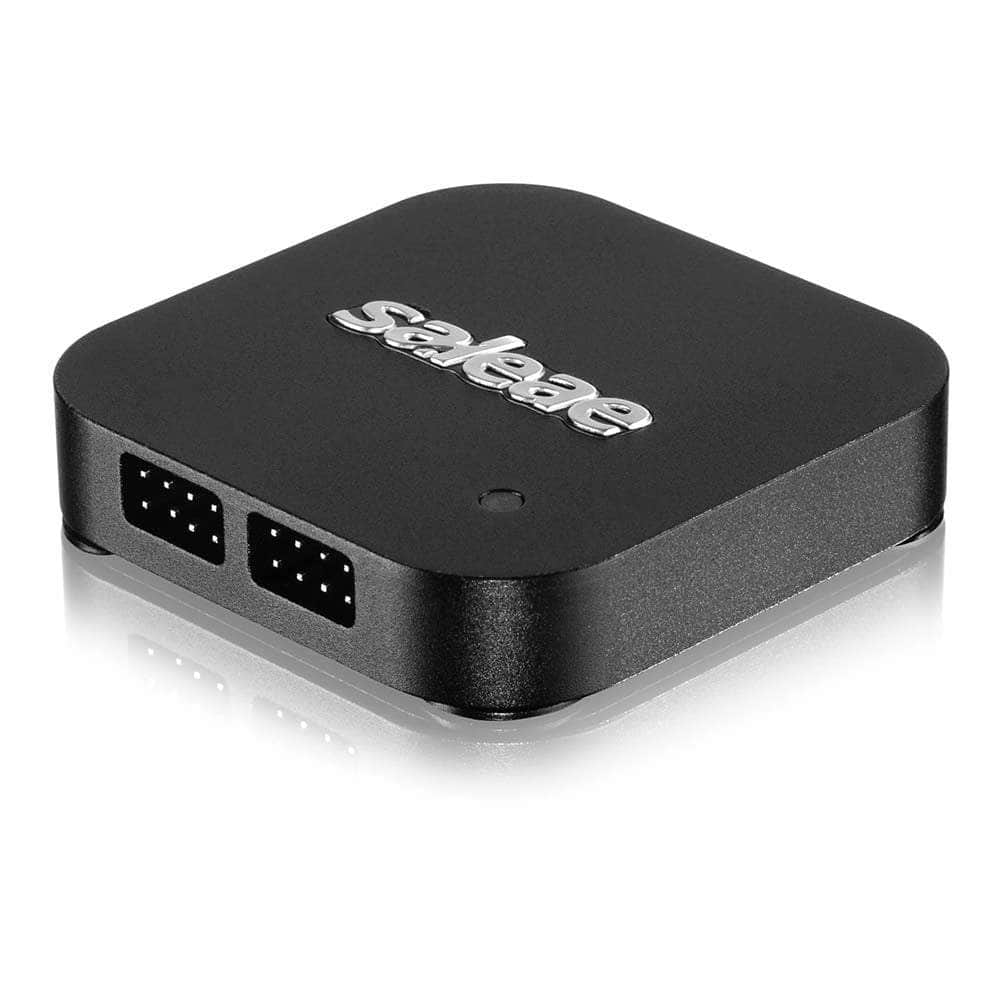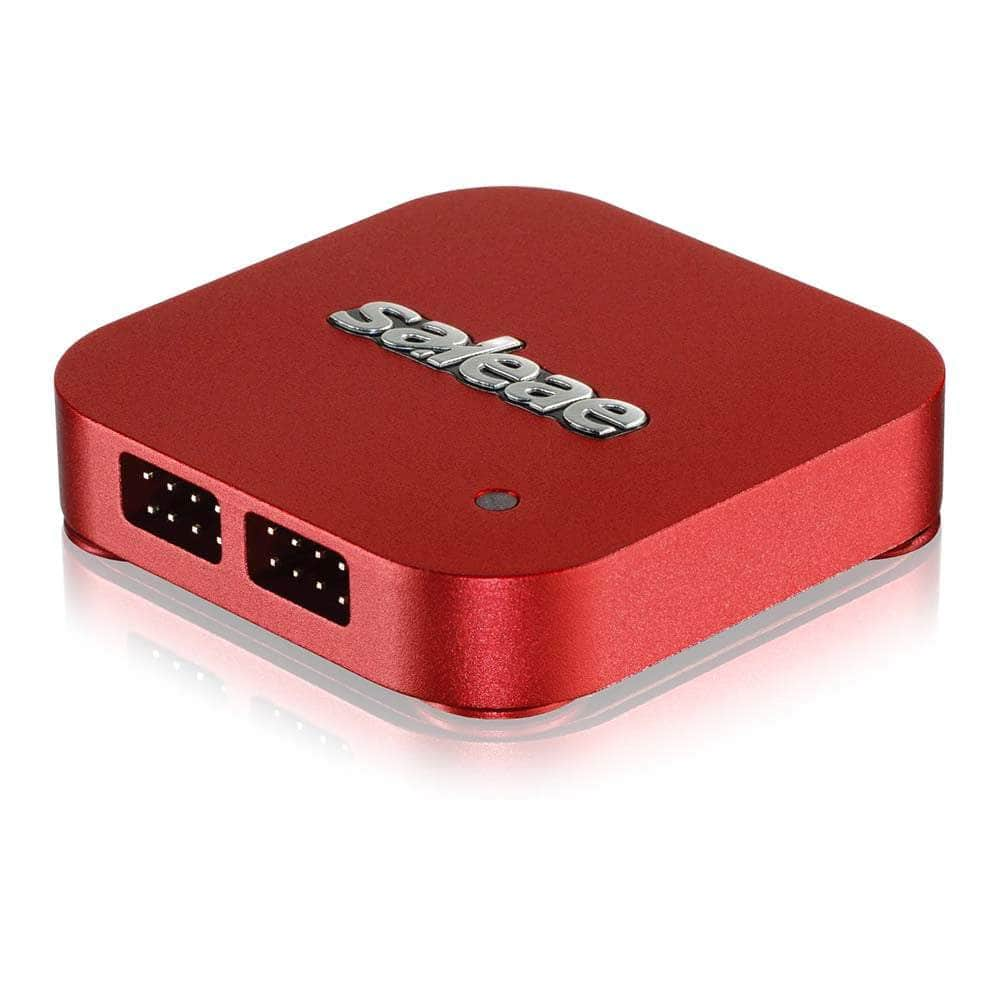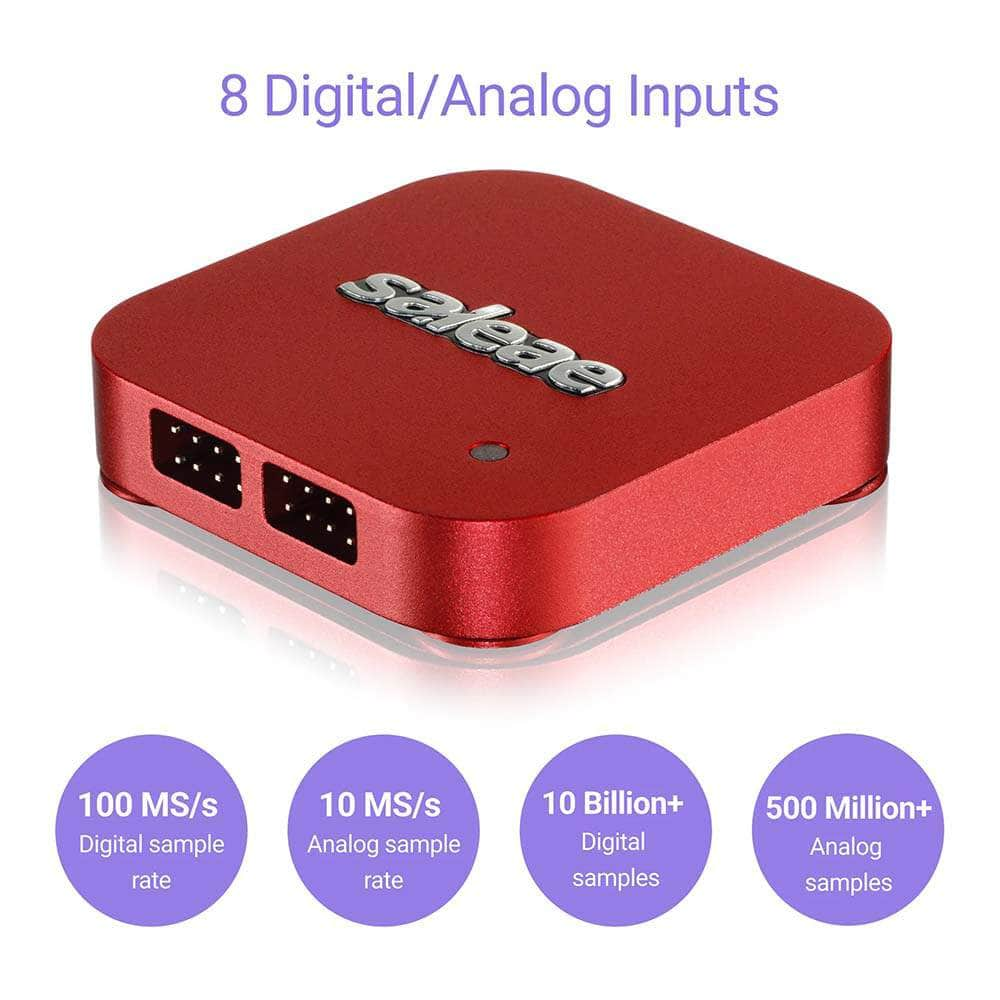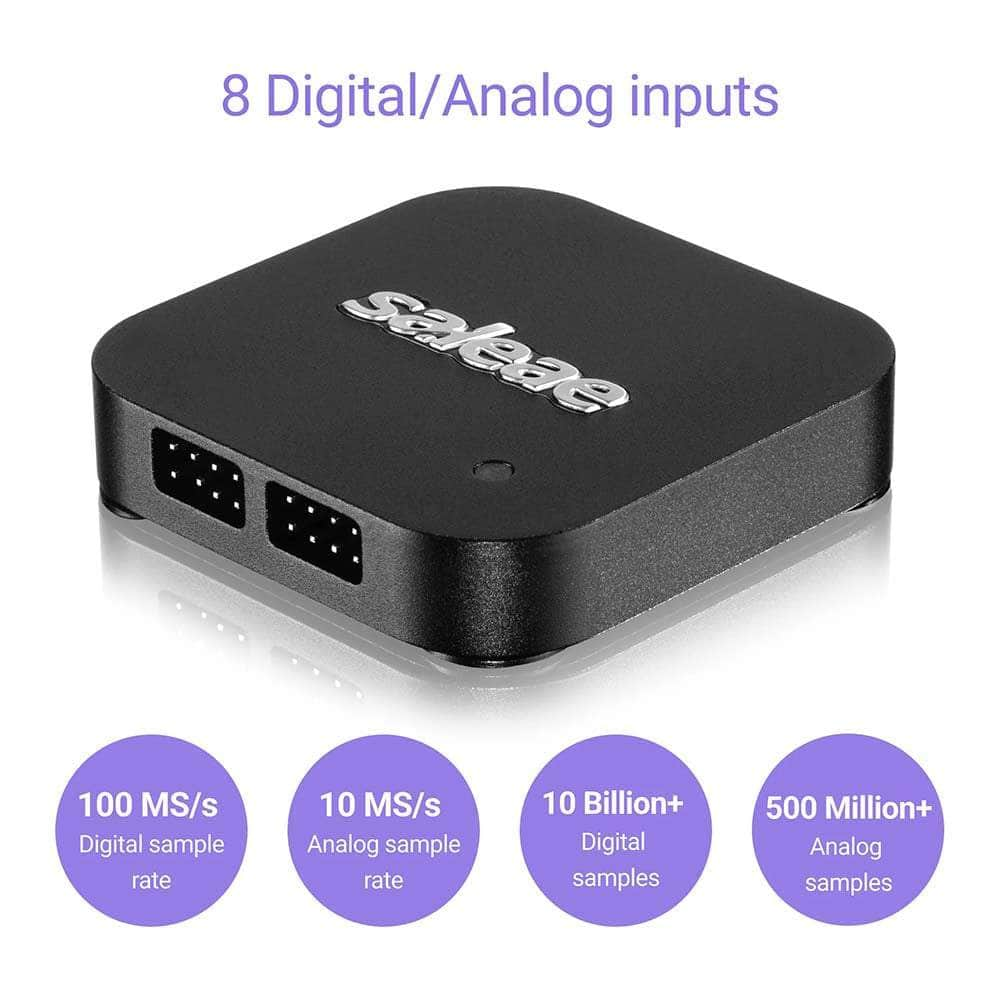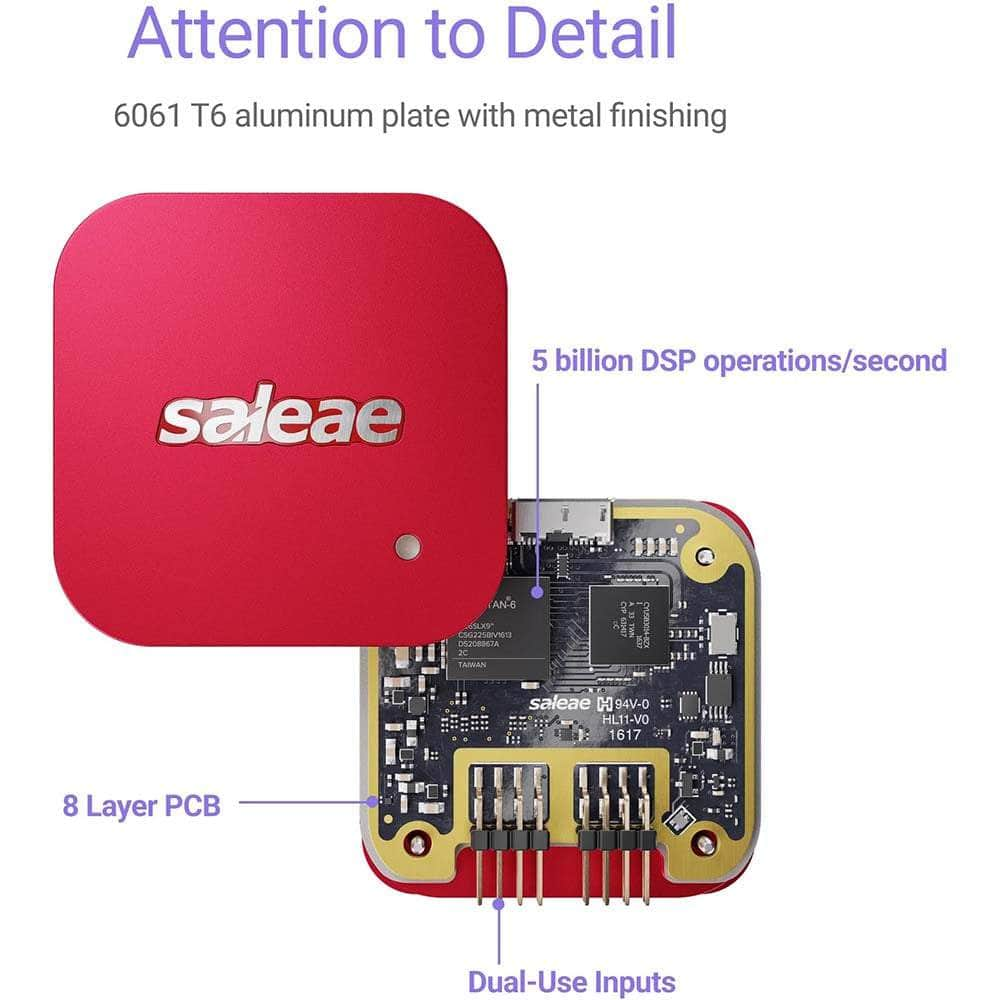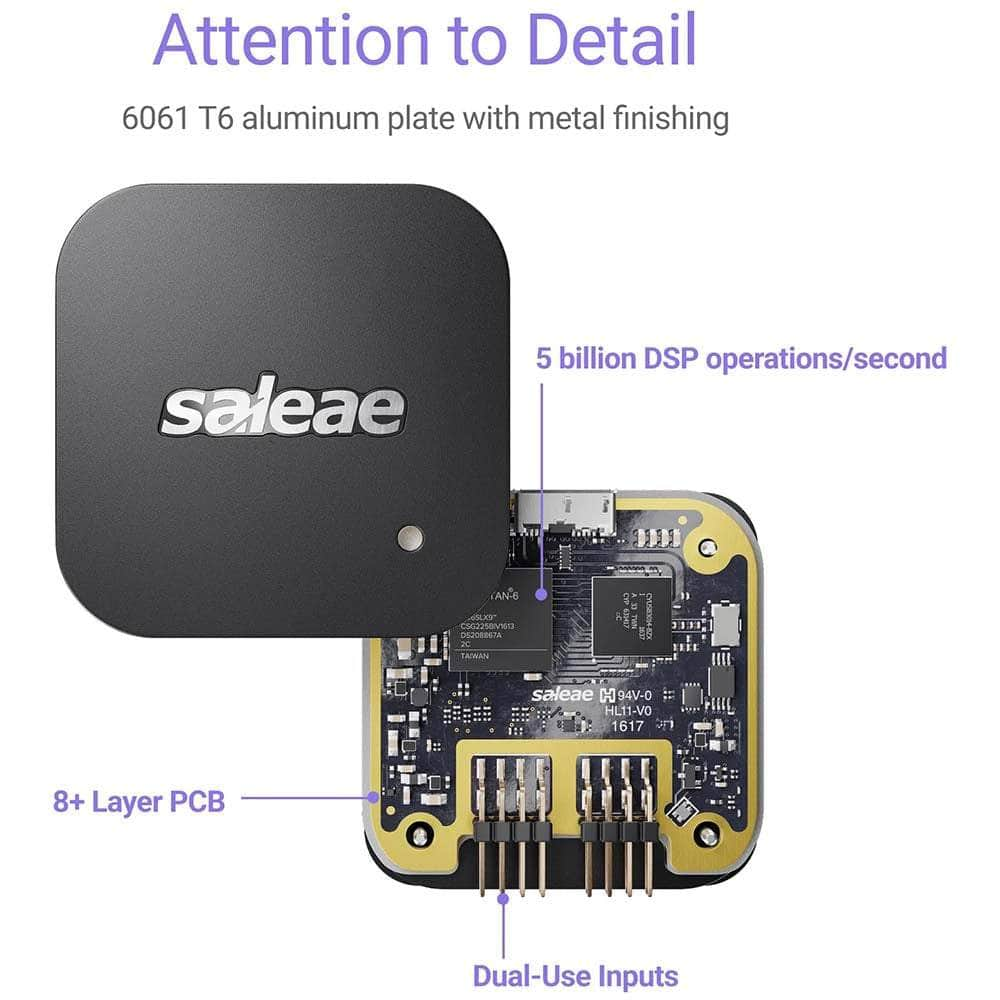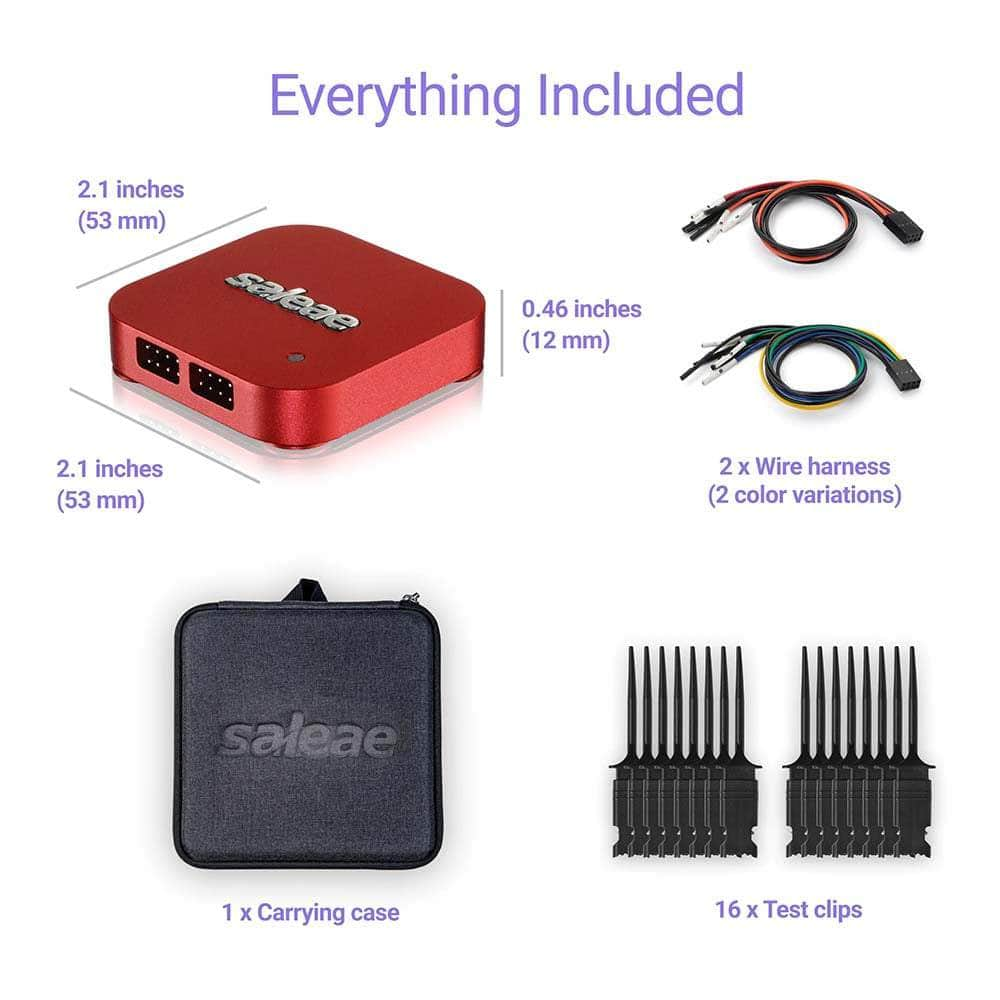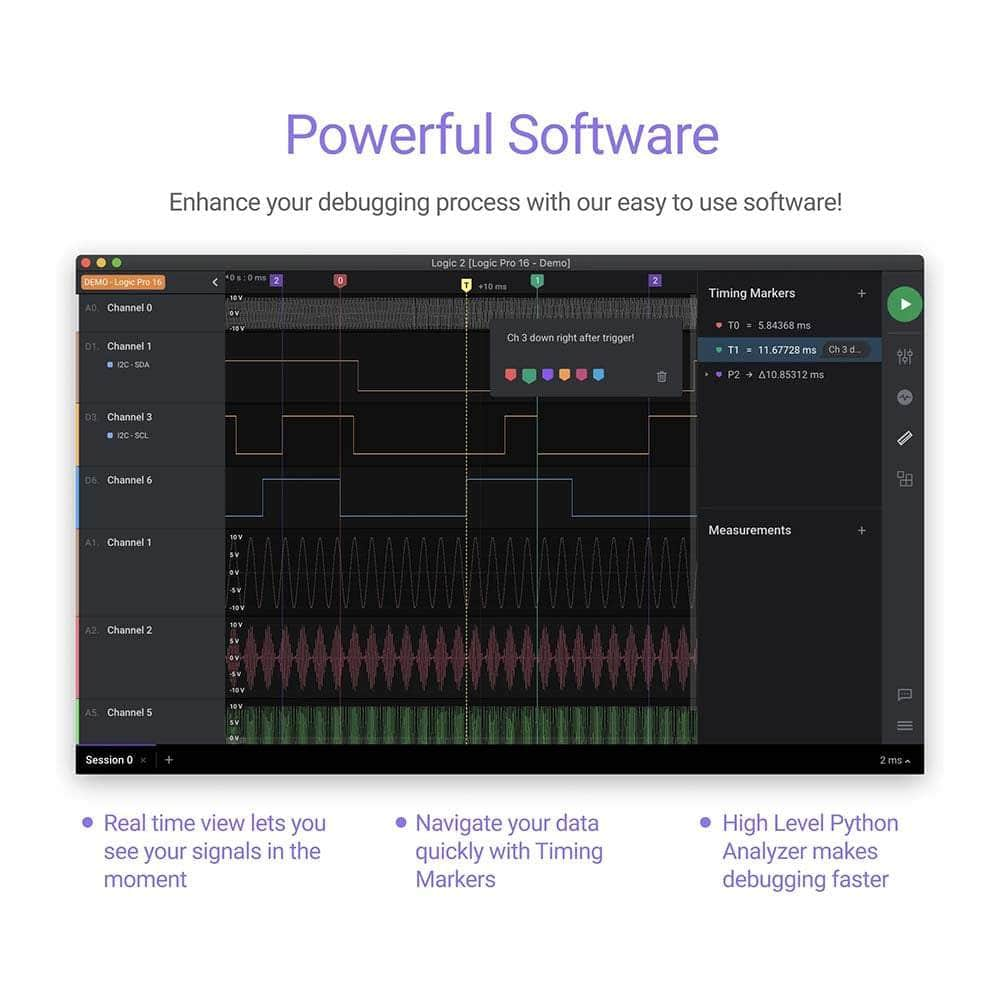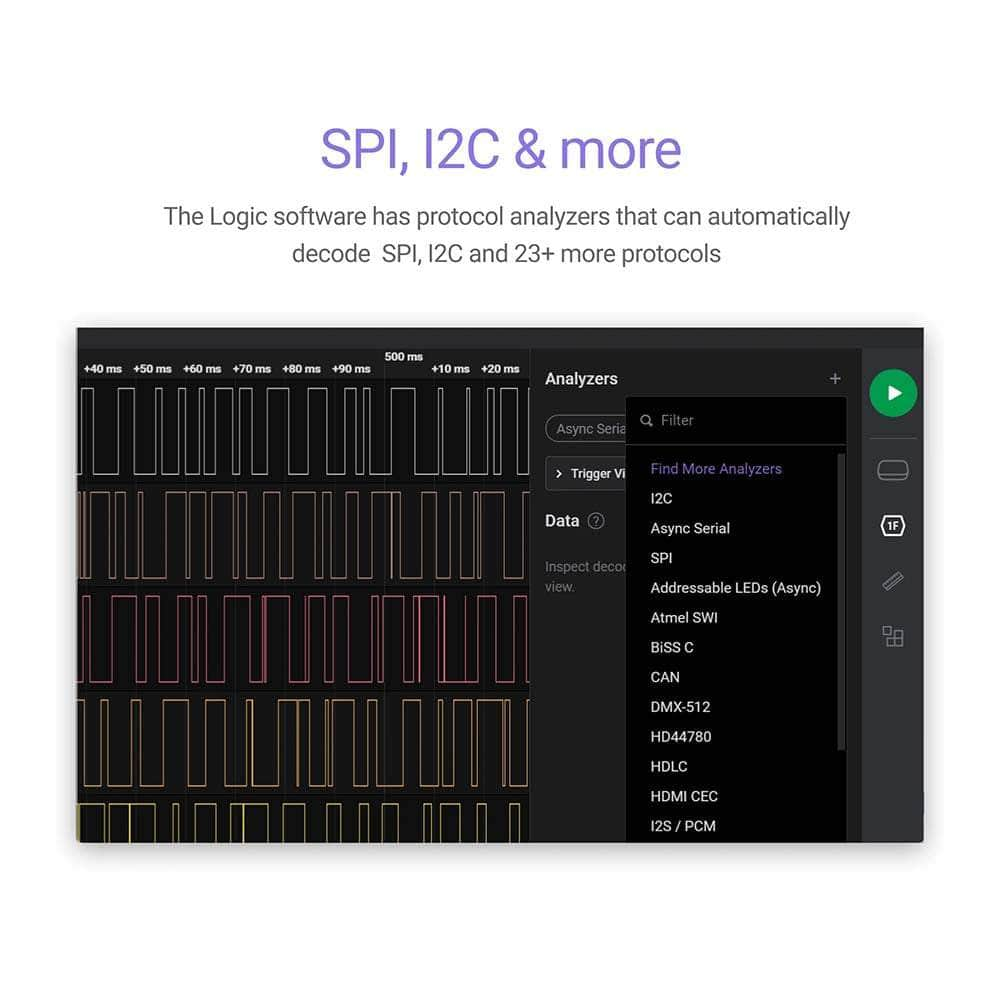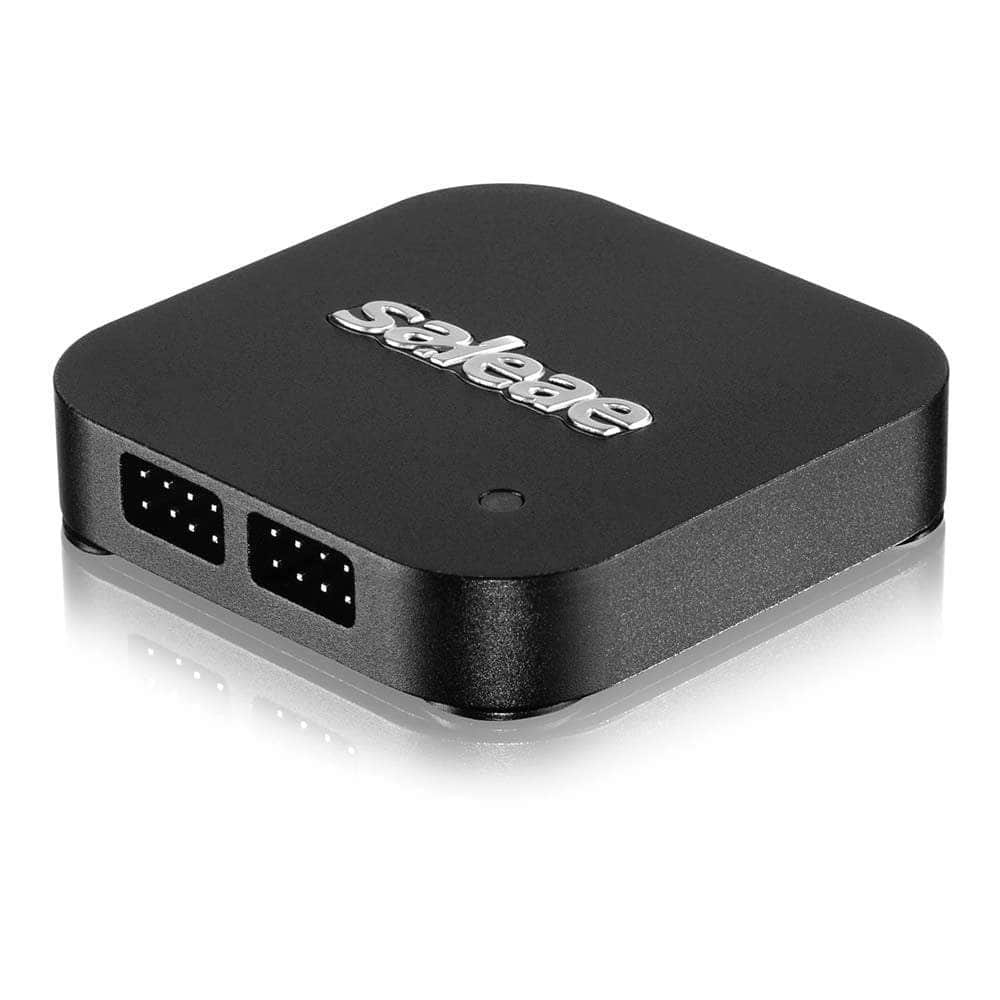
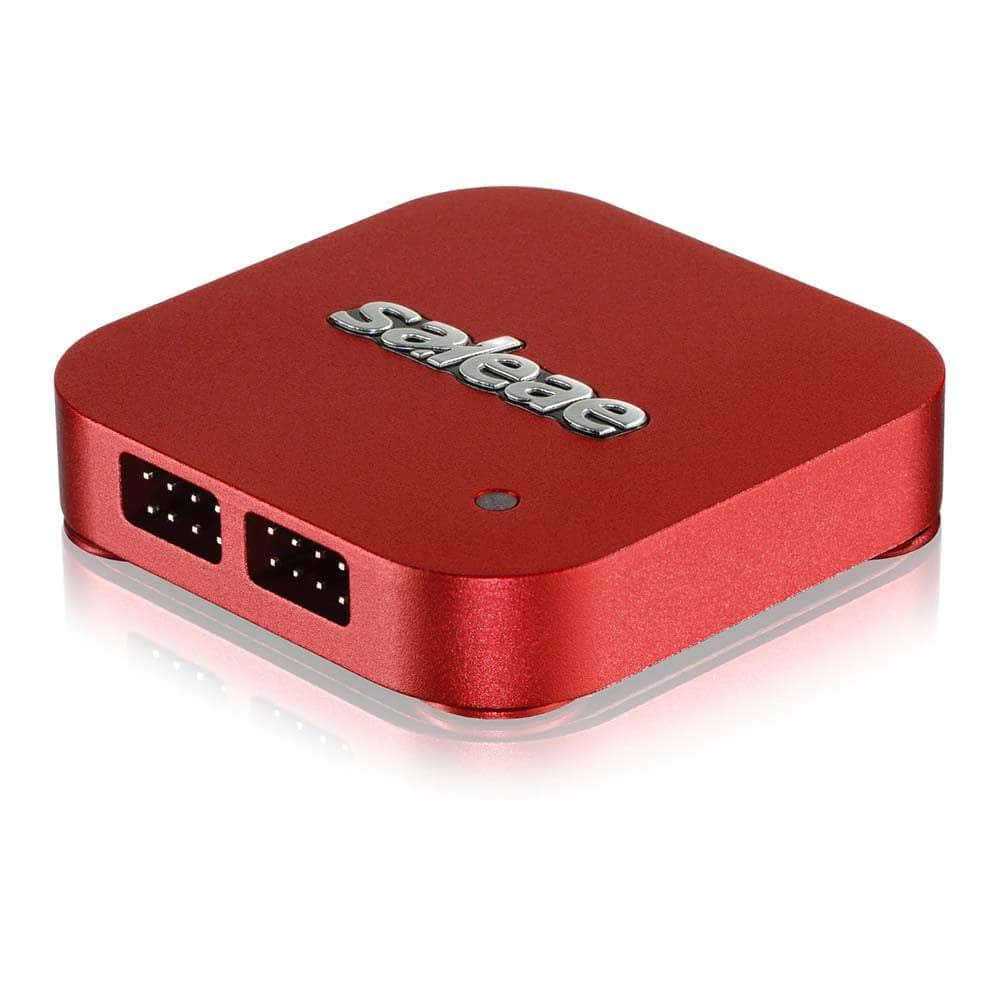
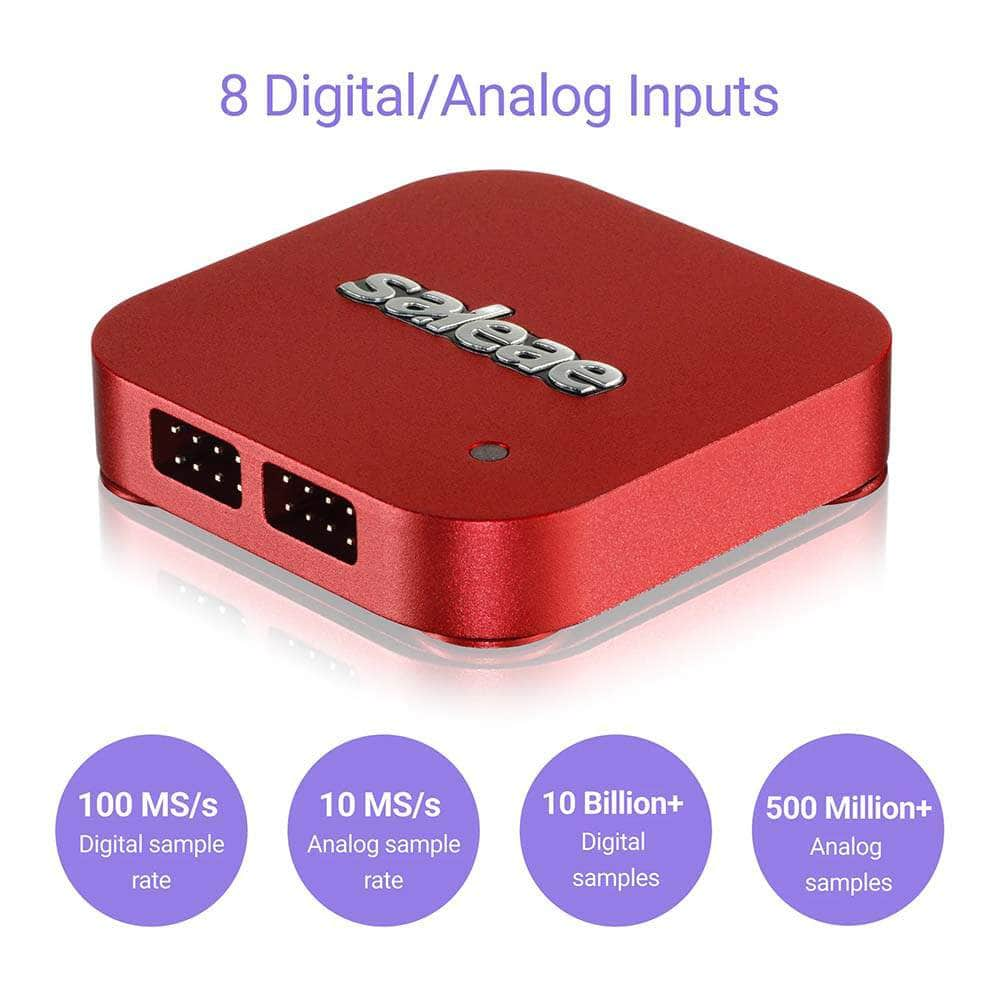
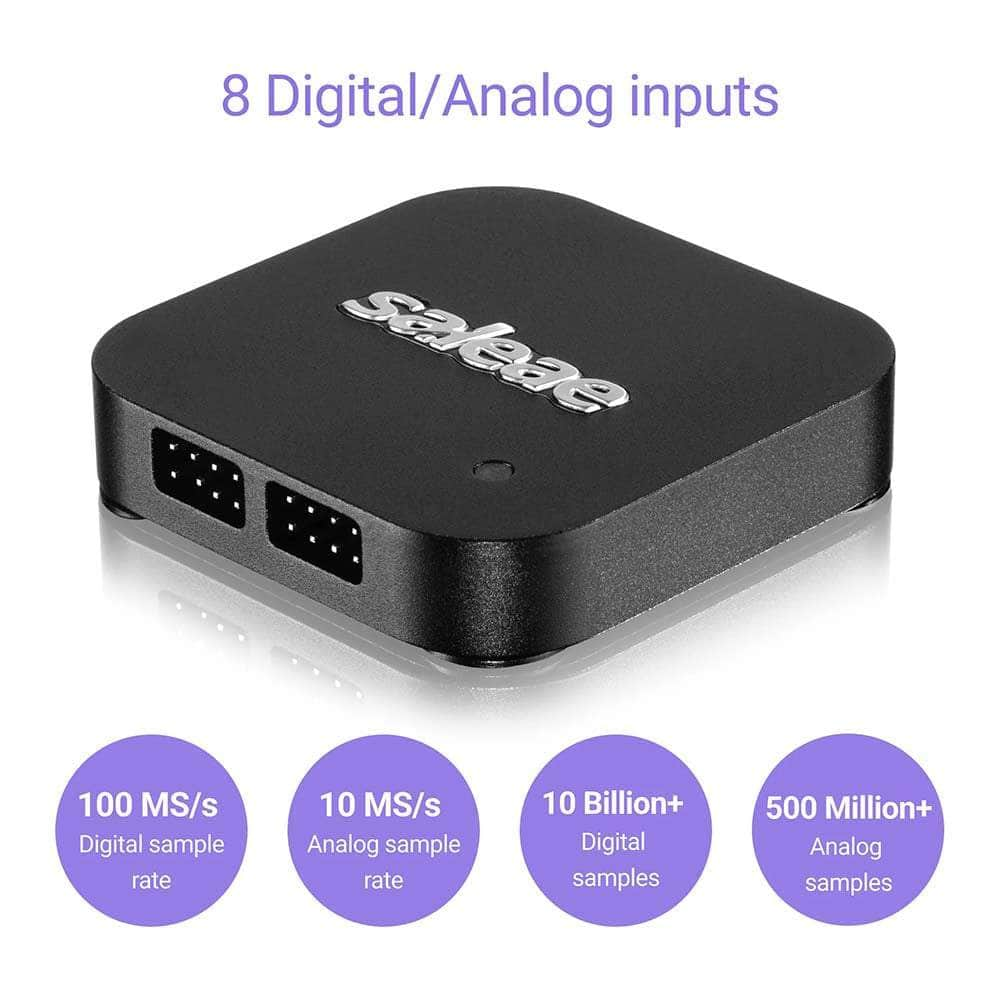
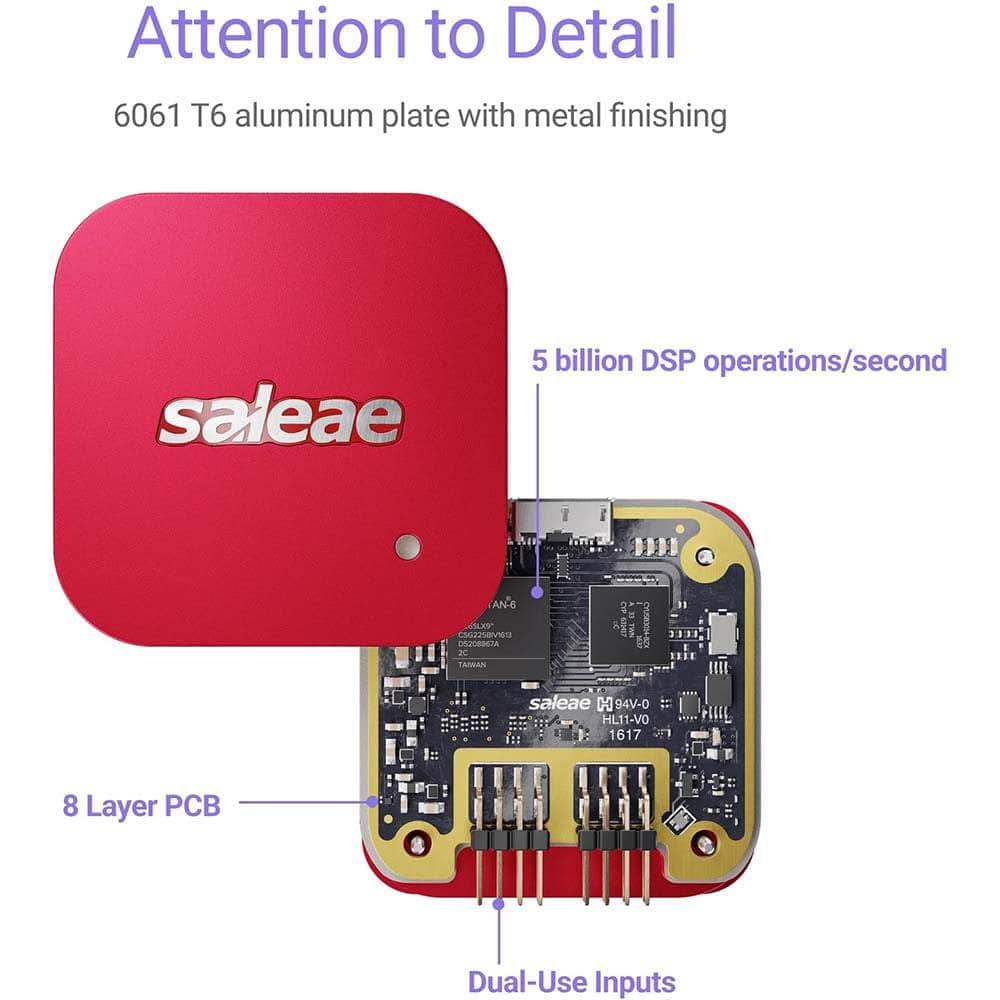
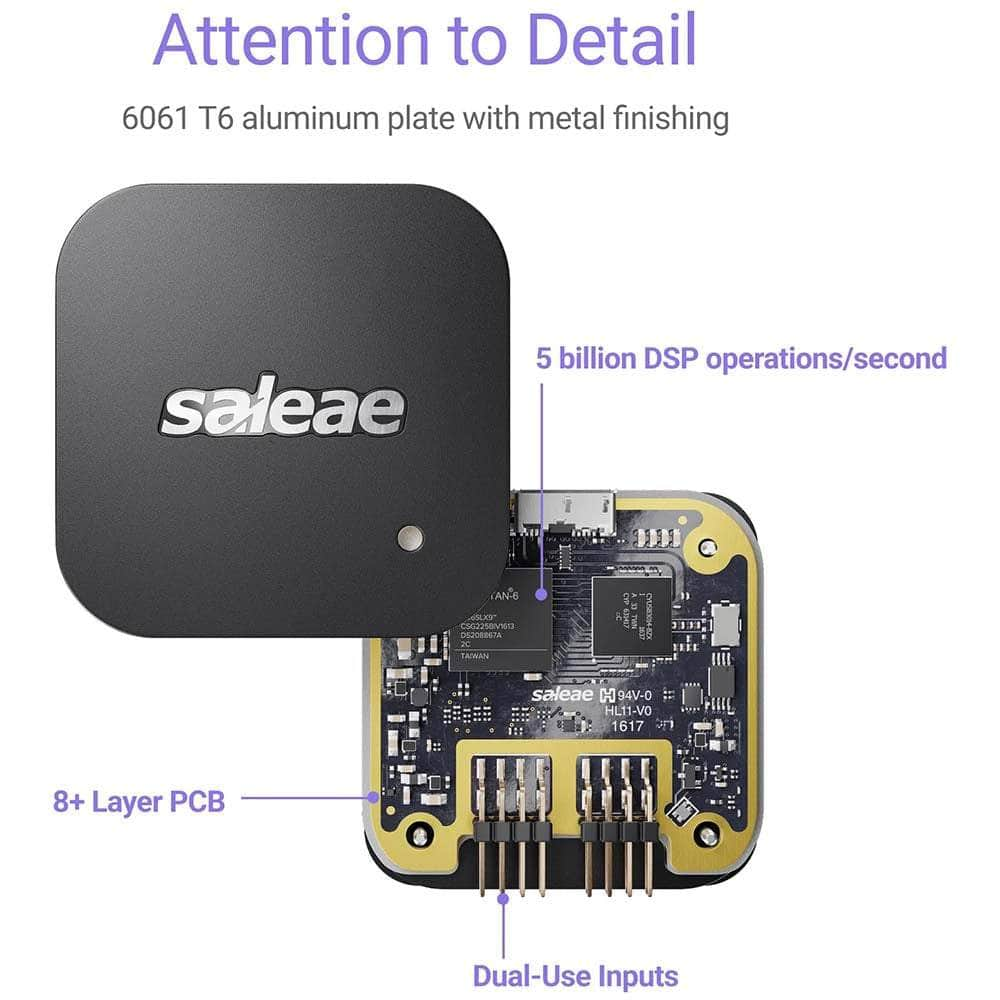
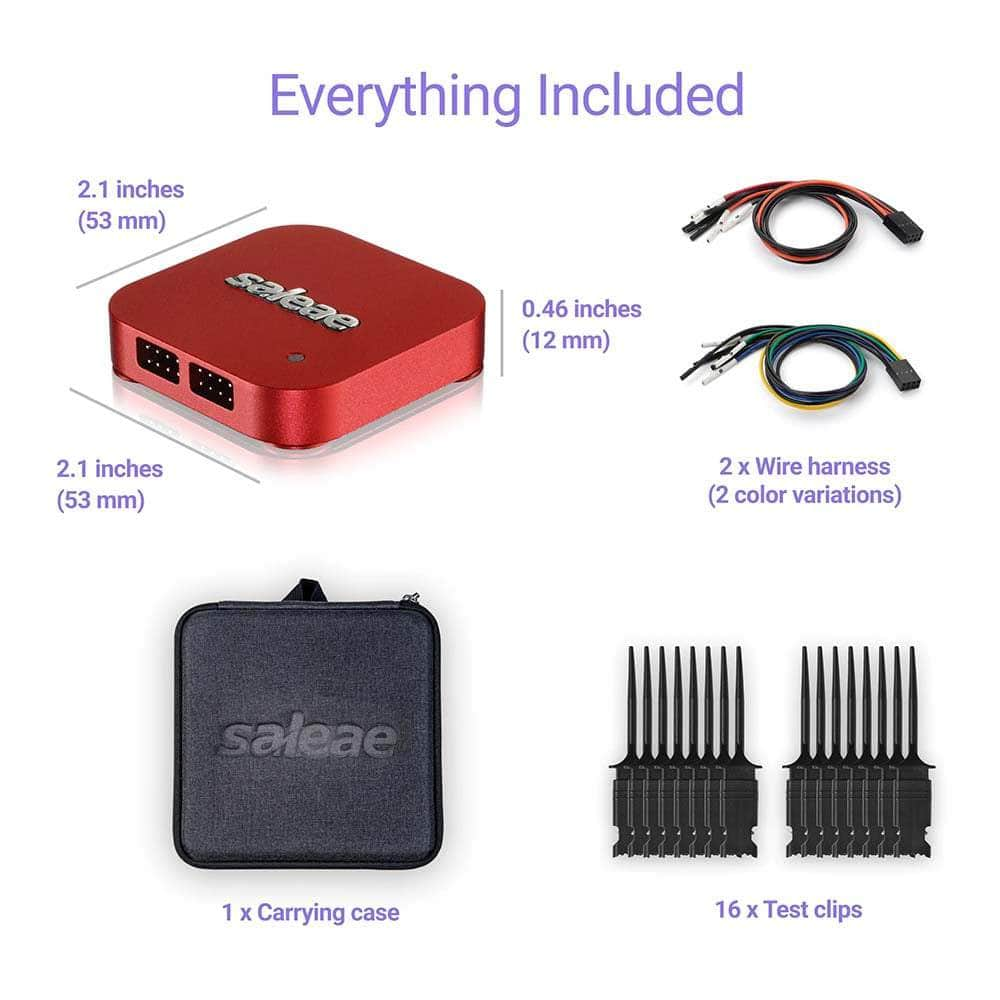
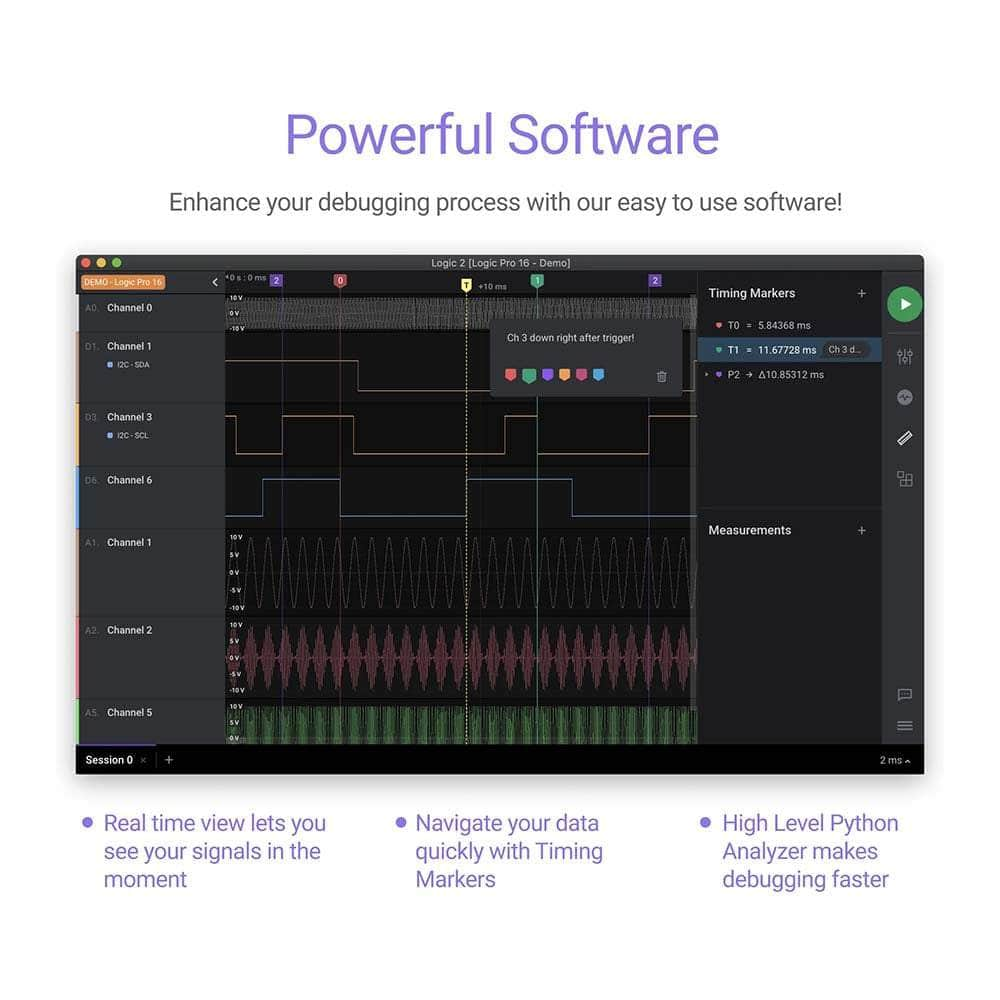
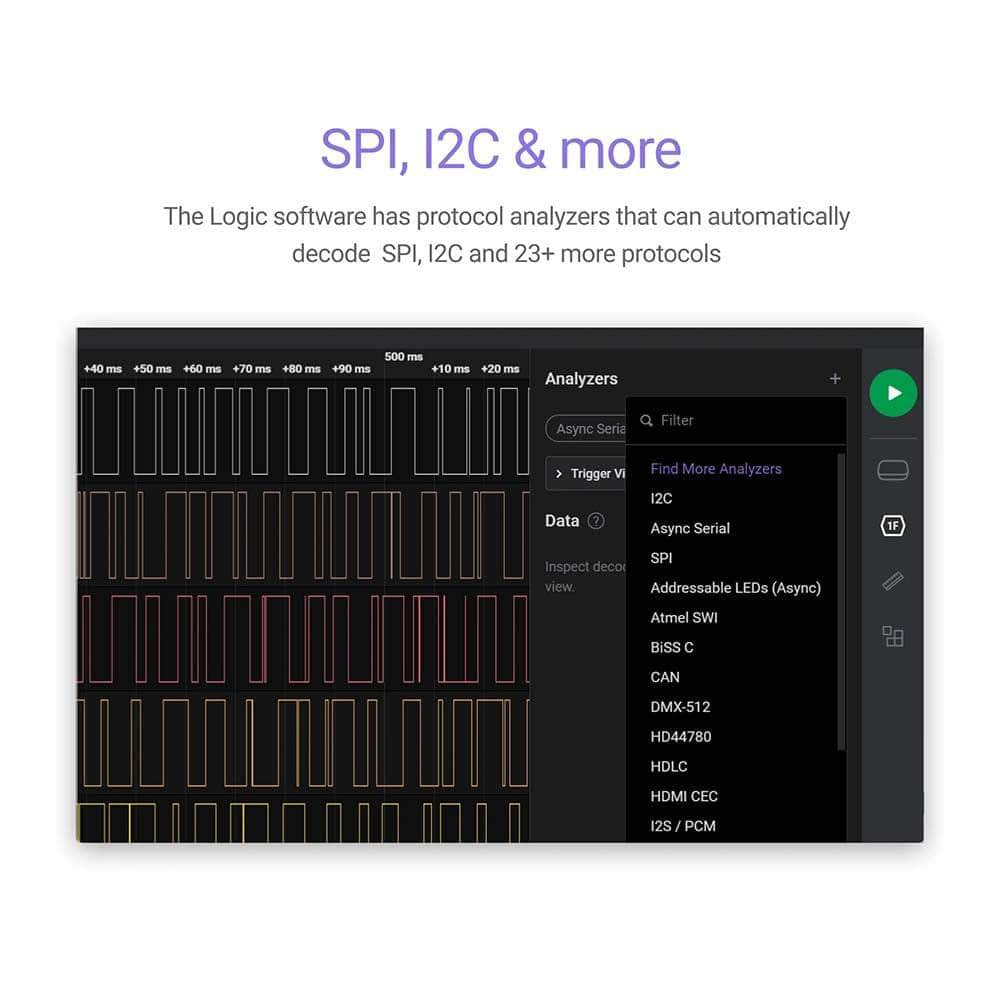
Key Features
Overview
The Saleae Logic 8 is a professional-grade mixed-signal USB logic analyser designed for embedded debugging, firmware validation, and protocol decoding. Compact yet powerful, this analyser offers eight channels that can be configured as digital, analogue, or both—providing unparalleled insight into mixed-signal systems.
With digital sample rates up to 100 MS/s on three channels (25 MS/s on all 8) and analogue capture at 10 MS/s (10-bit resolution), the Logic 8 delivers high-fidelity signal analysis with 25 MHz digital and 1 MHz analogue bandwidth. Real-time streaming directly into your computer’s RAM enables virtually unlimited capture length for tracking long or rare events.
The intuitive, cross-platform Saleae Logic 2 software supports over 24 built-in protocol decoders (SPI, I²C, UART, CAN, USB, JTAG, HDMI-CEC, and more), plus extensibility via plugin SDK and community decoders. Built to last, it features ±25 V input protection, a durable enclosure, and includes a 3-year no-questions-asked warranty and 180-day returns—trusted reliability for professional engineers.
Downloads
Why Engineers Choose The Saleae Logic 8 Logic/Analogue Analyser
Unlimited Capture via Real-Time Streaming
Fully Mixed-Signal on All 8 Channels
Compact Build with 3-Year Warranty
Full Description
Saleae Logic 8 is an 8-channel mixed-signal logic analyser designed for electronic design engineers who need to see both digital and analogue signals on the same timeline. Each of the eight inputs can be configured for digital or analogue capture, with digital sample rates up to 100 MS/s on three channels or 25 MS/s on all eight, and analogue sampling up to 10 MS/s at 10-bit resolution (≈1 MHz bandwidth). Combined with unlimited USB streaming and built-in protocol decoding for SPI, I²C, UART, CAN and more, it provides a powerful, compact tool for rapid debugging and validation.
Mixed-Signal Capture on Every Channel
All eight inputs can capture both digital and analogue signals simultaneously. With ±25 V input protection and software-adjustable thresholds, the Logic 8 connects safely to logic families from 1.2 V up to 5.5 V. For example, you can watch an I²C transfer at 400 kHz while monitoring the 3.3 V rail’s droop at the same instant. This makes it possible to identify not only that a transaction failed, but exactly why, by correlating protocol errors with analogue behaviour. The benefit is confidence in diagnosing root causes without switching between instruments.
Sampling Performance for Embedded Systems
The Logic 8 offers a 100 MS/s digital sample rate with three channels enabled, 50 MS/s with six channels, and 25 MS/s when all eight are active. Its analogue mode records at 10 MS/s, 10-bit resolution, with about 1 MHz analogue bandwidth. This covers most microcontroller buses such as SPI up to 25 MHz, UARTs at several Mbaud, and CAN or LIN networks, while also capturing analogue effects like ringing, crosstalk, and ground bounce. The benefit is full visibility of both the digital logic and the analogue environment that affects it.
Unlimited Streaming for Rare Event Detection
Rather than relying on a small on-device buffer, the Logic 8 streams data continuously over USB 2.0 into host RAM. Capture depth is limited only by your computer’s memory, allowing sessions that last minutes or hours. This capability is essential for catching elusive issues such as a watchdog reset after 45 minutes of runtime, or a UART framing error that appears once every 10,000 frames. The benefit is that rare and intermittent faults can finally be recorded and analysed with full timing context.
Protocol Analysis Made Simple
The Logic 2 software provides built-in support for more than 20 protocol analysers, including SPI, I²C, UART, CAN, LIN, MDIO and USB Low/Full-Speed. Decoded frames appear directly on the captured waveforms, aligned with the original edges. For example, you can inspect an SPI command at 12 MHz, see the data bytes decoded, and immediately correlate them with the analogue waveform. This eliminates manual decoding and dramatically reduces debug time, while ensuring protocol correctness and electrical integrity are considered together.
Flexible Logic Levels and Safe Probing
With support for logic families from 1.2 V up to 5.5 V and robust ±25 V protection, the Logic 8 can be safely connected to modern low-voltage microcontrollers, 3.3 V sensors, and legacy 5 V devices. Software-controlled thresholds allow precise adaptation to the system under test. The benefit is reliable probing across a wide range of designs without risking damage to the analyser or your circuit.
Everyday Debugging Scenarios
The Logic 8 is just as valuable for simple checks as for complex investigations. It can confirm that a UART running at 1 Mbaud is transmitting correctly, verify that an I²C EEPROM responds at 100 kHz, or ensure that an SPI DAC receives a 16-bit configuration word within 10 ms of reset. For longer sessions, continuous streaming makes it possible to capture CAN arbitration errors that only occur during heavy load, or to log a serial console until a random missing character appears. The benefit is clear visibility of both routine protocol traffic and hard-to-find faults.
Portable and Cross-Platform
Measuring just 53 × 53 × 12 mm and weighing around 60 g, the Logic 8 is compact and USB-powered, requiring no external supply. It is easy to move between benches or bring to a customer site. The Logic 2 software runs on Windows, macOS and Linux, and captures can be shared without the hardware attached. The benefit is a highly portable tool that fits seamlessly into collaborative workflows across different environments.
Why Engineers Choose Logic 8
By combining 8 mixed-signal channels, 100 MS/s digital sampling, 10 MS/s 10-bit analogue capture, support for 1.2–5.5 V logic with ±25 V protection, and unlimited USB streaming, the Saleae Logic 8 delivers the performance needed to solve both everyday debug tasks and elusive intermittent failures. Its integration of protocol decoding, analogue insight and long-duration recording shortens debug cycles and gives engineers the confidence to move from symptom to root cause quickly.
Related Products
Engineers needing more performance can upgrade to the Saleae Logic Pro 8 logic analyser, which provides 8 channels with up to 500 MS/s digital and 50 MS/s analogue sampling. For wider bus analysis, the Saleae Logic Pro 16 logic analyser offers 16 channels of mixed-signal capture at the same high speeds. For reliable probing, the Saleae Logic 2×4 Header (Gen 2) Cable provides a secure, durable connection for consistent measurement quality.
| General Information | |
|---|---|
Part Number (SKU) |
SAL-00111
|
Colour |
|
Manufacturer |
|
Data Sheet |
|
| Oscilloscope | |
Number of Channels |
|
Bandwidth |
|
Sample Rate |
|
Screen Size |
|
Touchscreen |
|
| Logic Analyser | |
Number of Logic Channels |
|
| Physical and Mechanical | |
Dimensions |
|
Weight |
0.5 kg
|
| Other | |
Warranty |
|
HS Code Customs Tariff code
|
|
EAN |
5055383614264
|
Frequently Asked Questions
Have a Question?
-
Is the Logic 8 suitable for professional embedded development work?
The Logic 8 is widely used in professional embedded development environments and is particularly valued for its reliability, comprehensive protocol support, and superior software experience. Its real-time streaming architecture and unlimited memory depth make it ideal for debugging complex embedded systems where traditional analysers with limited memory might miss critical events. The Logic 8's ability to simultaneously capture digital and analogue signals provides insights that separate instruments cannot match, whilst its portable form factor and robust design make it suitable for both laboratory and field applications. Many professional engineers choose the Logic 8 over significantly more expensive alternatives due to its superior usability and comprehensive feature set.
-
Can I extend Logic 8's capabilities with custom protocol analysers?
Absolutely. The Logic 8 supports extensive customisation through its Protocol Analyzer SDK and Extension API, allowing you to create custom low-level protocol analysers, high-level analysers, and measurement extensions. The extensions are written in Python for high-level analysers or C++ for low-level decoders, making them accessible to engineers with programming experience. The active Saleae community has contributed numerous extensions for specialised protocols, and Saleae provides comprehensive documentation and templates to help you develop custom analysers for proprietary protocols or specific measurement needs.
-
What warranty and support does Saleae provide for the Logic 8?
The Logic 8 includes Saleae's industry-leading 3-year no-questions-asked warranty that covers any malfunction regardless of cause, with all warranty service handled directly by Saleae rather than through distributors. Additionally, purchases direct from Saleae include a 180-day return policy with return shipping included. Saleae's support is widely regarded as exceptional within the test equipment industry, with comprehensive online documentation, active community forums, and responsive technical support that helps users maximise their investment.
-
Does the Logic 8 software work without the hardware for analysis and sharing?
Yes, the Saleae Logic software operates as a full-featured application without the hardware present, allowing you to analyse previously captured data, share recordings with colleagues, and demonstrate protocol behaviour. This capability is invaluable for collaborative debugging, technical support, and documentation purposes. You can save complete capture sessions and share them with other engineers who can then analyse the data using the free software, even without owning the hardware. This feature is particularly useful for remote troubleshooting and technical support scenarios where you need to share detailed timing and protocol information.
-
What is the actual bandwidth and sampling rate performance of the Logic 8?
The Logic 8 delivers 100 MS/s digital sampling on up to 3 channels simultaneously, 50 MS/s on up to 6 channels, or 25 MS/s across all 8 channels. The maximum digital bandwidth is 25 MHz, making it suitable for most embedded applications including USB Full Speed, moderate-speed SPI, and general microcontroller debugging. For analogue signals, it provides 10 MS/s sampling with 1 MHz bandwidth and 10-bit resolution. The USB 2.0 interface provides sufficient bandwidth for these sampling rates whilst maintaining real-time streaming to your computer's memory.
-
What protocol decoders are included with the Logic 8?
The Logic 8 includes over 24 built-in protocol analysers covering the most common embedded communication standards: SPI, I2C, Serial (UART), 1-Wire, CAN, I2S, JTAG, LIN, Manchester, MDIO, MIDI, Modbus, SMBus, USB, HDMI-CEC, HD44780, HDLC, DMX-512, and many others. Beyond the built-in decoders, the Logic 8 supports community-contributed extensions and custom protocol analysers through its plugin architecture, with over 47 community-developed extensions available. This extensive protocol support eliminates the need for separate protocol analysers and provides comprehensive debugging capabilities in a single instrument.
-
Can the Logic 8 simultaneously capture digital and analogue signals on the same channels?
Yes, the Logic 8's unique mixed-signal architecture allows all 8 channels to be configured as digital, analogue, or both simultaneously. This capability provides exceptional flexibility for debugging mixed-signal designs where you need to correlate digital protocol activity with corresponding analogue signal behaviour. The digital sampling operates at up to 100 MS/s whilst analogue sampling runs at 10 MS/s with 10-bit resolution and 1 MHz bandwidth, allowing you to observe both the logic states and underlying analogue characteristics of your signals in perfect time correlation.
-
How does the unlimited memory depth feature actually work?
The Logic 8 streams captured data directly over USB 2.0 to your computer's RAM in real-time, eliminating the memory constraints found in traditional logic analysers with fixed hardware buffers. This architecture means your capture length is limited only by your available system memory and the density of recorded data. Unlike traditional analysers that might offer only kilobytes or megabytes of storage, the Logic 8 can potentially record gigabytes or even terabytes of data, making it ideal for capturing long sequences or rare intermittent events that would be impossible to catch with conventional memory-limited instruments.
-
What makes the Saleae Logic 8 different from traditional logic analysers?
The Saleae Logic 8 revolutionises logic analysis by streaming data directly to your computer's RAM in real-time, providing virtually unlimited memory depth compared to traditional logic analysers with fixed buffer sizes. Unlike conventional bench instruments, it combines the portability of a USB device with professional-grade capabilities, featuring dual-purpose inputs that can simultaneously capture digital and analogue signals. The Logic 8's software-centric approach eliminates the complex button interfaces found on traditional analysers, instead offering an intuitive, cross-platform application with built-in protocol decoders and community extensions.

